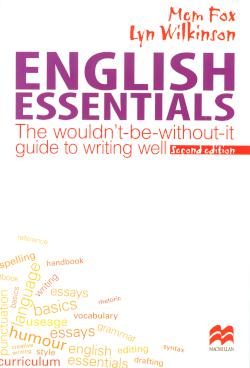English Essentials: the wouldn’t-be-without-it guide to writing well
This book was written with Lyn Wilkinson, one of my dearest colleagues. It was first published in 1993 and was updated and re-designed in mid-2011. It has now been around for twenty years, (2013) a huge achievement for a book of its kind. The intended audience is school students aged about 14 and upwards, university students, and anyone else who wants to write anything that matters, correctly and with vitality.
As university teachers, Lyn and I realized that all was not well with the literacy of our students, which is a polite way of saying there was a great weeping and wailing and gnashing of teeth whenever we marked another set of assignments, especially as our students were aiming to be teachers.
Many of our students came to us with quaint, outdated ideas of what constituted ‘good’ writing (e.g. ‘Never start a sentence with and, but or so.’ Such nonsense!); they found punctuation to be a minefield; they didn’t know what made a sentence correct or incorrect; they couldn’t tell the difference between an adjective and an antibiotic; most loathed writing of all kinds and had never realized it could be great fun, as well as a hugely rewarding activity; many who couldn’t spell thought it didn’t matter that much; the concept of paragraphs seemed never to have been grasped; and, like many of their teachers, the correct use of the colon had forever escaped them.
So we wrote this book in rage. And pity.
The first section explores how to write well; the second section explains how to write correctly. If, by any chance, readers were to read without a break from the beginning of the second section to the end they’d notice a story emerging: the same characters are used again and again in each new example, to keep a gossipy sort of interest alive.
Here’s a quote from Chapter One about the elements of good writing:
‘Good writing has a living, unique person behind it. It doesn’t sound as if it has been written by a soul-less computer in one office, for a mindless fax in another. It has personality. . .
‘When you write, let your personality, your real self, be heard in what you say and in the way you say it: that’s what ‘voice’ means. If you’re funny, be funny in your writing. If you’re zany, be zany. If you’re deeply sensitive, be deeply sensitive. . .
‘The presence of voice will indicate to readers that above and beyond the sweat and the bother, the writer has actually enjoyed writing the piece. Voice reveals a lively commitment to the writing task, a desire to be read, a high level of care. Let your voice be heard. It will make your writing come alive.
‘A warning: voice is generally discouraged in strictly academic writing, which is why so much of it is unspeakably dull even when the content is vitally important. There’s no point in fighting against this accepted norm: your future career may depend upon the standard of your academic writing. Regard it as a game to be played, learn its rules well and obey them. Knuckle down. Grit your teeth. Quieten your voice. But while you’re toiling away at essays and theses, denying your personality and even your existence as a writer, bear in mind that sharp editors outside academia actively search for novel and divergent kinds of writing, including those with a clear voice, to keep a much wider readership happy.
‘As an experienced writer, Mem now refuses to be restricted by rules that chafe against her better judgement so she does use voice in academic writing. She gets away with it by knowing the limits of her risk-taking. You may break any of the rules of writing, but only after you’ve obeyed them for such a long time that you are fully aware of what you are doing. It’s one of the many advantages of middle age.’
Here are the contents:
Part I: WRITING WITH STYLE AND EFFECT
- Chapter One: Elements of effective writing
- Chapter Two: Getting started
- Chapter Three: Drafting: Answering three important questions. Chapter Four: The nitty-gritty of re-writing.
Part II: WRITING CORRECTLY
- Introduction: Language and the conventions
- Chapter Five: Beginning at the beginning: basic terms
- Chapter Six: More about nouns
- Chapter Seven: More about adjectives and adverbs
- Chapter Eight: More about verbs
- Chapter Nine: So what’s a sentence, anyway?
- Chapter Ten: Three big problems in sentences
- Chapter Eleven: The basics of punctuation
- Chapter Twelve: Punctuating speech: “Show me how to do it,” you beg. Chapter Thirteen: The apostrophe of possession: Mem’s pet passion
- Chapter Fourteen: Getting spelling [write, rite, wrong or] right
- Chapter Fifteen: Prooffffff-reading with care
- Chapter Sixteen: On speaking correctly
- Chapter Seventeen: Is it this, or is it that?
- Chapter Eighteen: Final thoughts about writers and the writing process
- Chapter Nineteen: The effective writing checklist
- Chapter Twenty: The last word
In English Essentials we tried hard to model lively, correct and effective writing ourselves. It’s obviously aimed at anyone who wants to write well and correctly, from wide-awake twelve year olds to the members of writing groups in retirement villages, but our main focus group was high school and college students although we are aware of much wider use. We have reason to suspect it’s the upper levels of private schools and a few of the universities who are using it most often. In textbook terms, the sales of this book in Australia make it a best seller: approx 14,000. by mid 1997. It is not and will not be published in the USA which has enough such books of its own. English Essentials is quintessentially Australian. On purpose.


